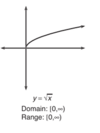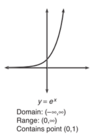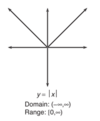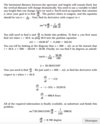Calculus Barrons Flashcards
(162 cards)
A derivative of the corner point at point c

What is the Mean Value theorem?
If the function is continuous between [a,b]. Then there must be some point (lets call this point x), where x’s derivative is equal to the average slope of a line connection points (a, y) and (b, y). This information is useful if you those problems that relate to getting a ticket for speeding. If you are travelling down a road and at point A, the police measure your speed to be 60 and then at point B, the police measure your speed to be 65, the time that it took you to travel from point A to point B (5 miles) is .25 hours. Then they can guarantee that at one point along your path from point A to B, you were going (5)/.25 mph at some point. In order to find out whether the Mean Value Theorem is satisfied check whether the function is continuous and then derive the function and check whether the are any values of [a, b] that make the derivative divided by 0 or any other discontinuity
In order for there to be a derivative at point C, then
- The function must be continuous at that point. Therefore no skips, jumps, holes.
What type of symetry does this function have?

Wrong bitch. The function is shifted 2 spaces to the right, therefore f(x) no longer equals f(-x).
Derivative of sec-1x

What is “find the line normal to the curve a point P” asking?
The normal line means the line that is perpendicular to the tangent at point P. Find the f’(x1) and before plugging it into the point slope form, plug in the inverse so 1/f’(x1).
Derivative of efunction
efunction times derivative of the function
What are considered critical values for the 1st derivative
when the 1st derivative = 0 or where the 1st derivative does not exist. also end points
Graph Cscx

Origin Symetry means the function is
The function is odd. f(-x) = -f(x)

Cot-1(x) in terms of tan
Cot-1(x) = pi/2 -tan-1(x)
Derivative of csc-1x

What geometric test must one to one functions pass
Horizontal Test
The formula that defines a derivative

Graph rad(x). Domain and Range?

What does -x2 look like in comparison to x2

List the power reducing formulas

Chapter 3, practice question 50.
lim x2 times sin(1/x)
as x approaches infinity
You can not just do sin(1/
What is this question asking? “Does limit as x approaches 1 exist in f(x)?”
The question is asking if from the left and right side of the function approach the same value. This same value does not have to be defined.
Derivative of Cotx
-csc2x
A function is one-to-one
If the function has 1 unique y value for each x value. Therefore in x2 f(-1) and f(1) producing the same y value of 1 would not be considered uniqe, x2 is not 1 to 1
Derivative of cos-1x

Classift Sinx, Cosx, and Tanx as either odd or even
Sinx - odd
Cosx - even
Tanx - odd
List the sum and difference formulas




















































































































